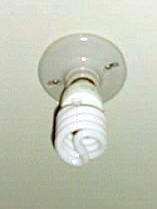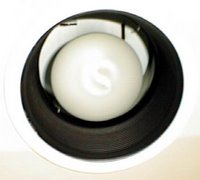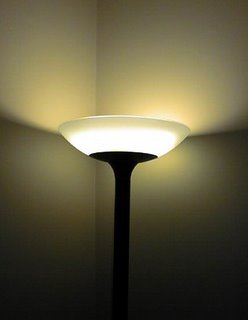Lighting (Mini-Projects, Relatively Cheap)
Over the past few years, I have been slowly replacing my incandescent light bulbs with lower wattage bulbs and Compact Fluorescent (CFL) bulbs. I want to make sure I have the right amount of light for each task and use the least amount of energy possible to do so. Conserving energy on the cheap requires a lot of little steps to make a big impact over time.
Standard incandescent bulbs run electricity through a wire. That wire gets white hot, and gives off light. The problem with this is that the heat created is lost energy and it increases cooling cost in the summer. It's inefficient, so it really doesn't help much in winter, either.
 CFL bulbs pass electricity through a gas, which gives off ultraviolet light, which makes the phosphor coating "fluoresce" - it gives off light. This uses a lot less electricity compared to an incandescent bulb that produces the same amount of light, and produces much less heat. In addition, CFLs can last up to 10 times as long as incandescent bulbs. This makes them great for those hard to reach spots. It also more than offsets the greater cost of CFLs over incandescent bulbs.
CFL bulbs pass electricity through a gas, which gives off ultraviolet light, which makes the phosphor coating "fluoresce" - it gives off light. This uses a lot less electricity compared to an incandescent bulb that produces the same amount of light, and produces much less heat. In addition, CFLs can last up to 10 times as long as incandescent bulbs. This makes them great for those hard to reach spots. It also more than offsets the greater cost of CFLs over incandescent bulbs.An 11 watt CFL replaces a 40 watt incandescent bulb.
A 15 watt CFL replaces a 60 watt incandescent bulb.
A 20 watt CFL replaces a 75 watt incandescent bulb.
A 23 watt CFL replaces a 100 watt incandescent bulb.
 Basically, each socket where an incandescent bulb is replaced by a CFL will use about 1/4 the energy, produce less heat, and last longer than an incandescent. While it might be tempting to replace every bulb with a CFL, not every socket is a good location for CFLs. Most CFL bulbs do not do well on motion detectors, rheostats/dimmers, or some types of timers. There are 3-way and dimmable CFLs, though I haven't found a dimmable that works too well, yet. There are spots, floods, bug lights, and colored lights, too.
Basically, each socket where an incandescent bulb is replaced by a CFL will use about 1/4 the energy, produce less heat, and last longer than an incandescent. While it might be tempting to replace every bulb with a CFL, not every socket is a good location for CFLs. Most CFL bulbs do not do well on motion detectors, rheostats/dimmers, or some types of timers. There are 3-way and dimmable CFLs, though I haven't found a dimmable that works too well, yet. There are spots, floods, bug lights, and colored lights, too.In cooler weather, CFL bulbs can start dimmer than full light output. It will start out dimmer than normal and gradually give out more light until it reaches its full brightness a minute or two later. Unless the bulb is specifically rated for it, it may not start if the temperature is 20°F or less.
 The first step is to replace incandescent bulbs that are on for several hours at a time with CFLs. Hallways, table lamps, torchieres, and some outdoor locations where lights are on for hours at a time are examples.
The first step is to replace incandescent bulbs that are on for several hours at a time with CFLs. Hallways, table lamps, torchieres, and some outdoor locations where lights are on for hours at a time are examples.Halogen torchieres are an especially good idea to replace - they not only use a lot of electricity, but can be a fire hazard as well. The Consumer Product Safety Commission (CPSC) issued a warning in 1996 because their tests indicated these lamps could start a fire in nearby combustible materials. CFL torchieres give off a similiar amount of light but with significantly less heat generation and electricity usage.
Once the most used bulbs have been replaced, consider replacing other well-used locations. Most of the bulbs in my home are now CFL. The few that aren't are on a rheostat dimmer. I tried one of the dimmable flood CFLs, but it didn't start well, and would flicker a bit when it finally decided to come on. The 3 way CFLs work well in lamps and the dimmable torchieres work just fine, so I'm hoping the next generation of dimmables works out better.

0 Comments:
Post a Comment
<< Home